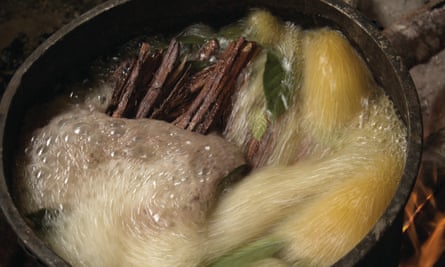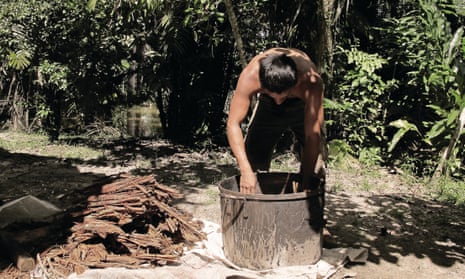Seated beneath the domed ceiling of a ceremony hall in Peru’s Sacred Valley, Martin (not his real name) picks some fruit out of the communal bowl.
“Basically, I confirmed what I’ve always known anyway – plants are sentient and self-aware, far more than we realise,” he says, before biting down into an apple.
The Dutch traveller has just emerged from several hours of what he believes were visions of the universe’s true nature after drinking a traditional Amazon medicine known as ayahuasca. The psychoactive concoction attracts thousands of foreigners annually to new-age healing retreats in Peru and neighbouring countries.
Traditionally, indigenous healers, known as curanderos, drink ayahuasca in order to diagnose their patients, whereas foreign-orientated retreats have the patients do the drinking.
Although the mountainous Sacred Valley region has little history of ayahuasca use – and its retreats need to import ingredients from the Amazon rainforest – tourists come from far and wide to try it here nonetheless.
According to research by Carlos Suárez Álvarez, Amazonian studies expert and author of Ayahuasca, Iquitos and Monster Vorāx, in Iquitos, the largest city in Peru’s Amazon, 10 of the 40 biggest camps reap nearly £5m annually by hosting foreigners for more than £1,000 per stay. This has led to prices of the Banisteriopsis caapi vine, which is the raw ingredient in ayahuasca, to more than triple just in the past six years.

Commercial plantations
Surging consumption from foreigners has seen the cost of the DMT-rich brew skyrocket, a familiar situation for locals already struggling to afford quinoa prices because of western demand.
Demand is such that even in the ayahuasca trail’s more traditional jungle heartland of Iquitos, shamans are having to reach out further and further into the wild to cater to tourists.
Suárez Álvarez says that the indigenous healers once foraged in the wild for ingredients “free from human contamination”. Today they typically rely on collectors to go on extended trips out in the jungle or to commercial plantations to source it.
“The vine is thinner, younger every time, and the local maestros always remark on the importance of the thickness and the age: the older and thicker, the better,” says Álvarez.
“A lot of people have started to have medium-large scale plantations, owned usually by business people from the city or from other parts of Peru,” he adds.
The take up of commercial planting will not solve the supply crisis immediately due to the slow growth of the vine, which can take five years to mature.
Overseas demand
Exacerbating the situation is overseas demand – with ayahuasca retreats springing up everywhere from Canada to Turkey, a largely unregulated export market has developed.
However, the economic benefit of this trade is hard to quantify because most industry sales are informal, says Mariella Landever Noriega, Peruvian founder of Chinchelejo, an exporter of plants including ayahuasca ingredients.Declining supply of ayahuasca ingredients was identified as an issue in an industry-wide survey conducted by the Ethnobotanical Stewardship Council (ESC) in 2014.
Short supply of chacruna leaves, for example, has prompted increased use of alternatives, such as huambisa and toé, with unpredictable and potentially deadly effects. These substances are particularly dangerous in the hands of the growing number of amateur curanderos implicated in deaths of a tourists, such as 18-year-old American Kyle Nolan.

Sources within the ayahuasca world say toé is used in excessive doses by inexperienced shamans primarily because it is an easy way to give tourists a powerful high, but also because of shortages of chacruna.
“It’s hard to know how prevalent toé use is – shamans have the right to keep their brew contents secret,” says Joshua Wickerham, former executive director of the ESC.
“High doses of toé are probably given more to fresh-off-the-plane people who get invited to the taxi driver’s cousin’s place and don’t know what a ceremony is supposed to be like. They might not complain if they have a bad time, and they might not remember anyway.”
Following that study the ESC secured funding for a garden to preserve ayahuascan varieties but the project never got off the ground. The organisation was dissolved in 2015, following a backlash against its push to introduce western-style market regulations to a world closely attached to its indigenous spiritual roots.
Future shortages
Jerónimo Mazarrasa, secretary of the board of directors at the International Center for Ethnobotanical Education Research and Service, says the market will sort out shortages.
“While I concede that wild aya has probably been harvested to death in a larger and larger radius all around Iquitos, I am not too worried about ayahuasca supply altogether,” he says. “Economical plants don’t go extinct, ever. Humans don’t allow it.”
But Brazilian medicinal plants specialist Thiago Martins e Silva, who played a key role in developing his country’s regulation of harvesting and transport of ayahuasca ingredients, is not so confident in the market as a saviour and is worried about deforestation of the Amazon as one of the major threats to wild stocks.
“Here, nobody pays to take ayahuasca,” he says. “What is sacred should not be for sale.”
Sign up to be a Guardian Sustainable Business member and get more stories like this direct to your inbox every week. You can also follow us on Twitter.










Comments (…)
Sign in or create your Guardian account to join the discussion